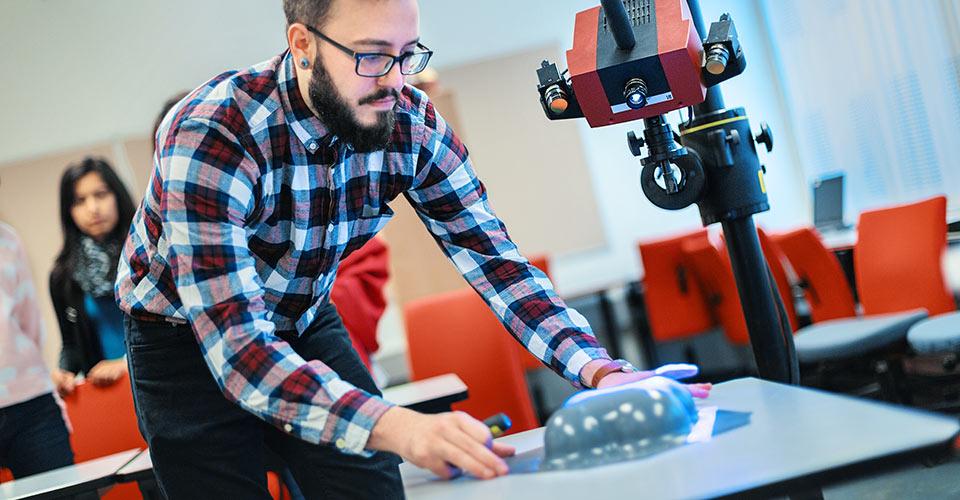
We are living in an era where science fiction has become fact and new innovations and technology emerge every day. Indeed, robotics and technological revolution have changed the world as we know it and our everyday lives. One of the most intriguing new technologies with real consumer applications is 3D printing. Technology is taking over and rapid prototyping technologies like 3D printing are democratizing innovation (De Jong & De Bruijn 2013).
Actually 3D printing or additive manufacturing (AM), as it is also called, was invented in the 1980’s. The printing is based on digital designs. The idea behind additive manufacturing is that it builds products layer-by-layer so that material is added. The difference between the traditional method of subtracting material through cutting is a paradigm shift (Campbell, Williams, Ivanova, & Garrett 2011). Recent improvements have made 3D printing available for consumers, mostly because of reduction of costs and availability of reasonably sized equipment. Andrew Zaleski (2015) argues that 2016 could be a breakout year for 3D printing. As with every other technology or appliance, consumer 3D printing is evolving rapidly and printers are becoming easily available and at a reasonable cost. There is constant innovation activity occurring with 3D printers. However, you do not necessarily need to own your own 3D printer as there are plenty of options to choose from listed in 3dhubs.com, covering also 3D printing service providers in Finland.
So what does 3D printing mean for consumers? Is it just for printing different sized and shaped pieces of plastic? Well that is the current reality but if we didn’t have to consider the high costs, huge equipment, or lack of technology, what could 3D printing hold for consumers? Ordering food from home could be changed to 3D printing your chicken tikka or hot wings with the help of your laptop and a printer. Just download the recipe and a model and press enter. Or if you have run out of your prescription medicine just call your doctor, renew your prescription, and print the pills at home. What about online shopping? Instead of waiting for your new shirt or jeans to arrive via postal service, why not just pay the order online, download the model and print the clothes with your 3D device? Recycling could also take a gigantic leap with 3D printing. Think about for example kids’ toys. Most of them are discarded after a few uses and new toys are bought. Toys are mostly plastic and quite simple models. What if you could just melt the old toys into raw material and print new toys for your kids? Very eco-friendly, don’t you agree? There are growing communities in the internet sharing 3D designs. Among the most popular 3D design communities for discovering, printing, and sharing is Thingiverse.com with over 1.000.000 members and over 600.000 designs. The amount of communities and services sharing 3D printing related STL-files and designs is rapidly growing.
There are plenty of 3D printing-related solutions available also for consumers. The following are some future scenarios for 3D printing applications for the consumer market. Tired of your home decoration and worn out sofas? Log in to your IKEA account, shop for new furniture models, and print the furniture at home. Or better yet, why not have an architect design a new house for you and off you go printing your brand new home. There are also more medical applications for consumers: replace a lost ear by printing a new one from your own stem cells. Need a new liver? Not a problem: let your 3D printer print you one. The fountain of youth or at least a source of new body parts may be closer than we think.
Obviously we are far from most of the 3D consumer applications listed above. But we have seen the development of technology in the last 100 years, and it has been exponential. What used to take centuries or decades, takes only years or months now. There shouldn’t be any limitations for what 3D printing can do for industries, companies, or consumers. We have already become accustomed to smartphones, tablets and other high-tech devices and applications, so 3D printing at home may very well be the next technology supporting our everyday lives.
References:
Campbell, T., Williams, C., Ivanova, O., & Garrett, B. (2011). Could 3D printing change the world? Atlantic Council. Retrieved 8 December 2016 from http://www.atlanticcouncil.org/publications/reports/could-3d-printing-change-the-world
De Jong, J. P., & De Bruijn, E. (2013). Innovation lessons from 3-D printing. MIT Sloan Management Review, 54(2), 43.
Zaleski, A. (2015). Here’s Why 2016 Could Be 3D Printing’s Breakout Year. Fortune, 30 December 2015. Retrieved 8 December 2016 from http://fortune.com/2015/12/30/2016-consumer-3d-printing/
This article is a part of Innovation management collection.
Authors
Minna-Liisa Halme, Antti Lind, Anna Nisula and Jonna Tuovinen are students for the degree of Master of Business Administration.
Mikko Mäntyneva (Ph.D.) is a Principal Lecturer in the Master’s Degree Programme in Business Management and Entrepreneurship. He is also a research manager at HAMK’s Smart Services Research Unit.
Reference to the publication:
Halme, M-L., Lind, A., Nisual, A., Tuovinen, J., & Mäntyneva, M. (2016). Innovation in 3D printing for consumers. In M. Mäntyneva (ed.) Innovaatiojohtaminen. HAMK Unlimited Professional 15.12.2016. Retrieved [date] from https://unlimited.hamk.fi/yrittajyys-ja-liiketoiminta/innovation-in-3D-printing-for-consumers/
http://urn.fi/URN:NBN:fi-fe2020111991912

This material is CC licensed Attribution-ShareAlike 4.0 International.
[button href=”http://www.hamk.fi/english/applicants/business-management-and-entrepreneurship/Sivut/default.aspx” target=”_blank” bg_color=”#FF0066″ text_color=”#ffffff”]Business Management and Entrepreneurship »[/button]





